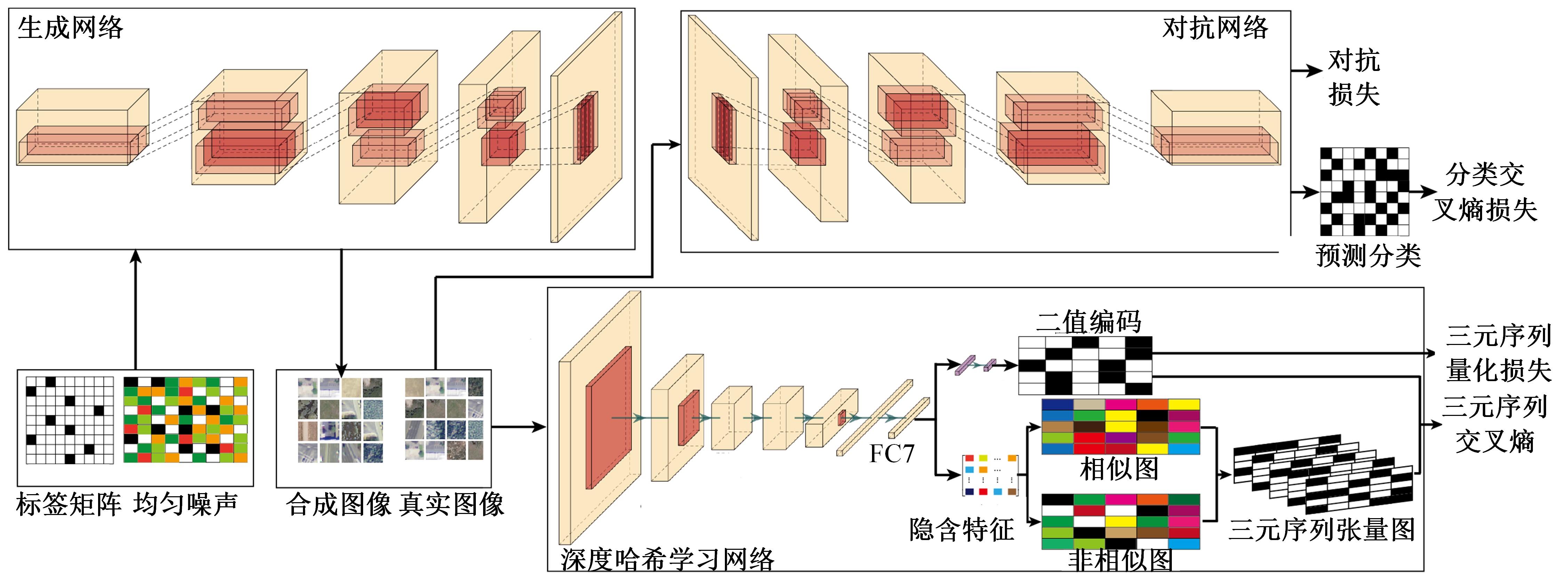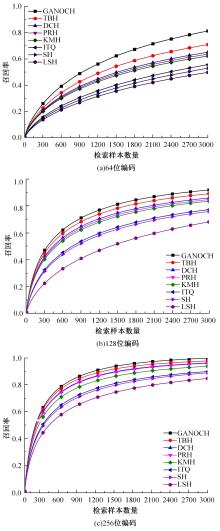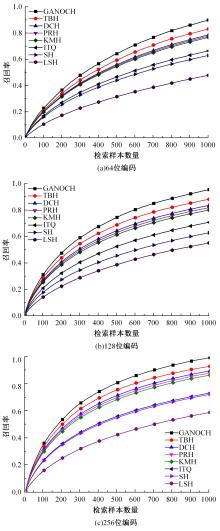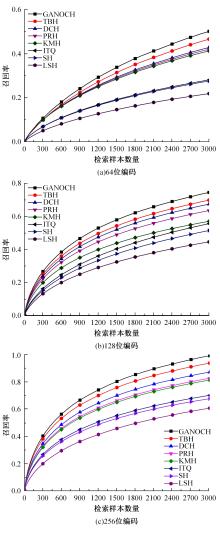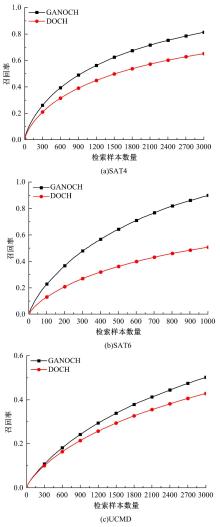吉林大学学报(工学版) ›› 2023, Vol. 53 ›› Issue (12): 3536-3546.doi: 10.13229/j.cnki.jdxbgxb.20220048
• 计算机科学与技术 • 上一篇
基于生成对抗网络的序列交叉熵哈希
- 1.山东理工大学 计算机科学与技术学院,山东 淄博 255022
2.吉林大学 符号计算与知识工程教育部重点实验室,长春 130012
Ordinal cross entropy Hashing based on generative adversarial network
Zhen WANG1,2( ),Xiao-han YANG1,Nan-nan WU1,Guo-kun LI1,Chuang FENG1
),Xiao-han YANG1,Nan-nan WU1,Guo-kun LI1,Chuang FENG1
- 1.School of Computer Science and Technology,Shandong University of Technology,Zibo 255022,China
2.Key Laboratory of Symbolic Computation and Knowledge Engineering of Ministry of Education,Jilin University,Changchun 130012,China
摘要:
为了快速响应遥感图像的近邻检索请求,提出了基于生成对抗网络的序列交叉熵哈希(GANOCH)。首先,建立了基于交叉熵的序列保持目标函数,确保任意三元组样本在不同空间内的序列相似性关系具有相同的概率分布,增强了序列保持约束性。然后,为解决优化过程中的非确定性多项式(NP)难问题,对目标函数中的离散编码进行了连续化松驰处理,并建立了基于三元序列交叉熵的量化损失函数,以减少由连续化过程引起的误差。同时,构造了基于类别标签矩阵的监督生成对抗网络,以增广训练数据集,避免由数据不足或不均衡导致深度网络发生过拟合。最后,在UCMD、SAT4和SAT6遥感数据集上设置了近邻检索性能对比实验,结果表明,基于生成对抗网络的序列交叉熵哈希的近邻检索性能较优。
中图分类号:
- TP391.41
| 1 | Shan Xue, Liu Ping-ping, Wang Yi-fan, et al. Deep Hashing using proxy loss on remote sensing image retrieval[J]. Remote Sensing, 2021, 13(15): No. 2924. |
| 2 | Shan Xue, Liu Ping-ping, Gou Gui-xia, et al. Deep hash remote sensing image retrieval with hard probability sampling[J]. Remote Sensing, 2020, 12(17): No. 2789. |
| 3 | 冯小康, 彭延国, 崔江涛, 等. 基于最优排序局部敏感哈希索引[J]. 计算机学报, 2020, 43(5): 930-947. |
| Feng Xiao-kang, Peng Yan-guo, Cui Jiang-tao, et al. Locality sensitive Hashing index based on optimal linear order[J]. Chinese Journal of Computers, 2020, 43(5): 930-947. | |
| 4 | 赵宏伟, 王振, 杨文迪, 等. 熵选择多重二进制编码[J].吉林大学学报: 工学版, 2017, 47(1): 218-226. |
| Zhao Hong-wei, Wang Zhen, Yang Wen-di, et al. Multiple binary codes based on entropy selection[J]. Journal of Jilin University: Engineering and Technology Edition, 2017, 47(1): 218-226. | |
| 5 | Hou Yong, Wang Qing-jun. Research and improvement of content based image retrieval framework[J]. International Journal of Pattern Recognition and Artificial Intelligence, 2018, 32(12): No.1850043. |
| 6 | Wang J, Liu W, Sanjiv K, et al. Learning to hash for indexing big data—a survey[J]. Proceedings of the IEEE, 2016, 104(1): 34-57. |
| 7 | Wang Jing-dong, Zhang Ting, Song Jing-kuan, et al. A survey on learning to hash[J]. IEEE Transactions on Pattern Analysis & Machine Intelligence, 2018, 40(4): 769-790. |
| 8 | Mayur D, Nicole I, Piotr I, et al. Locality-sensitive Hashing scheme based on p-stable distributions[C]∥Proceedings of the Annual Symposium on Computational Geometry, New York, USA, 2004: 253-262. |
| 9 | Weiss Y, Torralba A, Fergus R. Spectral Hashing[C]∥Proceedings of the Advances in Neural Information Processing Systems, British Columbia, Canada, 2008: 1753-1760. |
| 10 | Gong Y C, Svetlana L. Iterative quantization: a procrustean approach to learning binary codes[C]∥Proceedings of the IEEE Conference on Computer Vision and Pattern Recognition (CVPR), CO, USA, 2011: 817-824. |
| 11 | He Kai-ming, Wen Fang, Sun Jian. K-means Hashing: an affinity-preserving quantization method for learning binary compact codes[C]∥Proceedings of the IEEE Conference on Computer Vision and Pattern Recognition (CVPR), OR, USA, 2013: 2938-2945. |
| 12 | Cao Yue, Long Ming-sheng, Liu Bin, et al. Deep Cauchy Hashing for Hamming space retrieval[C]∥Proceedings of the IEEE Conference on Computer Vision and Pattern Recognition (CVPR), UT, USA, 2018: 1229-1237. |
| 13 | Shen Yu-min, Qin Jie, Chen Jia-xin, et al. Auto-encoding twin-bottleneck Hashing[C]∥Proceedings of the IEEE Conference on Computer Vision and Pattern Recognition (CVPR), WA, USA, 2020: 2815-2824. |
| 14 | Li Peng, Ren Peng. Partial randomness Hashing for large-scale remote sensing image retrieval[J]. IEEE Geoscience & Remote Sensing Letters, 2017, 14(3): 464-468. |
| 15 | He Jun-feng, Liu Wei, Chang Shih-fu. Scalable similarity search with optimized kernel Hashing[C]∥Proceedings of the ACM International Conference on Knowledge Discovery and Data Mining, Washington, DC, USA, 2010: 1129-1138. |
| 16 | Liu Hao-miao, Wang Rui-ping, Shan Shi-guang, et al. Deep supervised Hashing for fast image retrieval[J]. IEEE Conference on Computer Vision and Pattern Recognition, 2016, 127(9): 2064-2072. |
| 17 | Li Yan-sheng, Zhang Yong-jun, Huang Xin, et al. Large-scale remote sensing image retrieval by deep Hashing neural networks[J]. IEEE Transactions on Geoscience and Remote Sensing, 2017, 56(2): 950-965. |
| 18 | Fan Li-li, Zhao Hong-wei, Zhao Hao-yu. Distribution consistency loss for large-scale remote sensing image retrieval[J]. Remote Sensing, 2020, 12(1): No. 175. |
| 19 | Kamran G, Zheng F, Najmeh S, et al. Unsupervised deep generative adversarial Hashing network[C]∥Proceedings of the Conference on Computer Vision and Pattern Recognition, UT, USA, 2018: 3664-3673. |
| 20 | Radford A, Metz L, Chintala S. Unsupervised representation learning with deep convolutional generative adversarial networks[C]∥Proceedings of the International Conference on Learning Representations, San Juan, Puerto Rico, 2016: No.06434. |
| 21 | Cao Yue, Liu Bin, Long Ming-sheng, et al. HashGAN: Deep learning to hash with pair conditional wasserstein GAN[C]∥Proceedings of the 2018 IEEE Conference on Computer Vision and Pattern Recognition (CVPR), Salt Lake City, UT, USA, 2018:1287-1296. |
| 22 | Martín A, Soumith C, Léon B. Wasserstein generative adversarial networks[C]∥Proceedings of the International Conference on Machine Learning 2017, Sydney, NSW, Australia, 2017: 214-223. |
| 23 | Augustus O, Christopher O, Jonathon S. Conditional image synthesis with auxiliary classifier GANs[C]∥Proceedings of the International Conference on Machine Learning, Sydney, NSW, Australia, 2017: 4043-4055. |
| 24 | Alex K, Ilya S, Geoffrey E H. Image-Net classification with deep convolutional neural networks[C]∥Proceedings of the NIPS, Nevada, United States, 2012: 1106-1114. |
| 25 | Yang Y, Shawn D N. Bag-of-visual-words and spatial extensions for land-use classification[C]∥Proceedings of the International Conference on Advances in Geographic Information Systems, Association for Computing Machinery, San Jose, California, 2010:270-279. |
| 26 | Saikat B, Sangram G, Supratik M, et al. DeepSat: a learning framework for satellite imagery[C]∥Proceedings of the International Conference on Advances in Geographic Information Systems, Association for Computing Machinery, Seattle, Washington, 2015: 1-10. |
| [1] | 薛珊,张亚亮,吕琼莹,曹国华. 复杂背景下的反无人机系统目标检测算法[J]. 吉林大学学报(工学版), 2023, 53(3): 891-901. |
| [2] | 时小虎,吴佳琦,吴春国,程石,翁小辉,常志勇. 基于残差网络的弯道增强车道线检测方法[J]. 吉林大学学报(工学版), 2023, 53(2): 584-592. |
| [3] | 周丰丰,颜振炜. 基于混合特征的特征选择神经肽预测模型[J]. 吉林大学学报(工学版), 2023, 53(11): 3238-3245. |
| [4] | 王俊杰,农元君,张立特,翟佩臣. 基于施工场景的视觉关系检测方法[J]. 吉林大学学报(工学版), 2023, 53(1): 226-233. |
| [5] | 朱冰,李紫薇,李奇. 基于改进SegNet的遥感图像建筑物分割方法[J]. 吉林大学学报(工学版), 2023, 53(1): 248-254. |
| [6] | 秦贵和,黄俊锋,孙铭会. 基于双手键盘的虚拟现实文本输入[J]. 吉林大学学报(工学版), 2022, 52(8): 1881-1888. |
| [7] | 曲福恒,丁天雨,陆洋,杨勇,胡雅婷. 基于邻域相似性的图像码字快速搜索算法[J]. 吉林大学学报(工学版), 2022, 52(8): 1865-1871. |
| [8] | 白天,徐明蔚,刘思铭,张佶安,王喆. 基于深度神经网络的诉辩文本争议焦点识别[J]. 吉林大学学报(工学版), 2022, 52(8): 1872-1880. |
| [9] | 刘铭,杨雨航,邹松霖,肖志成,张永刚. 增强边缘检测图像算法在多书识别中的应用[J]. 吉林大学学报(工学版), 2022, 52(4): 891-896. |
| [10] | 方世敏. 基于频繁模式树的多来源数据选择性集成算法[J]. 吉林大学学报(工学版), 2022, 52(4): 885-890. |
| [11] | 王生生,李晨旭,王翔宇,姚志林,刘一申,吴佳倩,杨晴然. 基于改进残差胶囊网络和麻雀搜索的脑瘤图像分类[J]. 吉林大学学报(工学版), 2022, 52(11): 2653-2661. |
| [12] | 车翔玖,陈赫元. 基于改进YOLOv4的多目标光盘检测算法[J]. 吉林大学学报(工学版), 2022, 52(11): 2662-2668. |
| [13] | 王生生,陈境宇,卢奕南. 基于联邦学习和区块链的新冠肺炎胸部CT图像分割[J]. 吉林大学学报(工学版), 2021, 51(6): 2164-2173. |
| [14] | 赵宏伟,张子健,李蛟,张媛,胡黄水,臧雪柏. 基于查询树的双向分段防碰撞算法[J]. 吉林大学学报(工学版), 2021, 51(5): 1830-1837. |
| [15] | 曹洁,屈雪,李晓旭. 基于滑动特征向量的小样本图像分类方法[J]. 吉林大学学报(工学版), 2021, 51(5): 1785-1791. |
|
||

